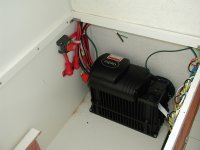Well, it's been a while since we've discussed onboard battery chargers. I pulled all our batteries out, checked water levels, and connections. The battery switch has been problematic, but some WD-40 and exercise seems to have taken care of that. The Guest charger that the factory installed has been replaced once and this replacement seems to not be giving a charge to the start battery.
So, the options are: replace the Guest with the same thing and not have to mess around with wiring, OR go with something different and mess with wiring. It wouldn't hurt my feelings to have some sort of a meter/read-out, as well.
So, any suggestions? Thanks in advance!
Best wishes,
Jim B.
So, the options are: replace the Guest with the same thing and not have to mess around with wiring, OR go with something different and mess with wiring. It wouldn't hurt my feelings to have some sort of a meter/read-out, as well.
So, any suggestions? Thanks in advance!
Best wishes,
Jim B.


